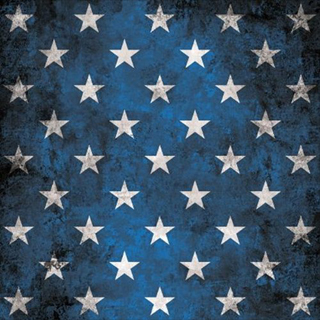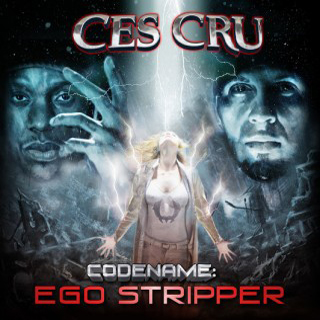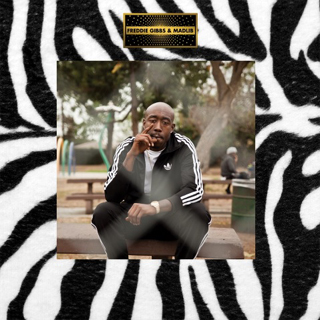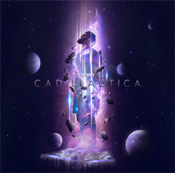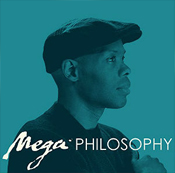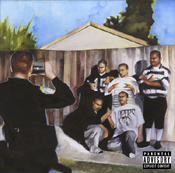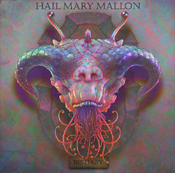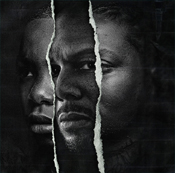At the end of every year, since I started writing these top ten lists in late 2009, I’ve been plagued by one question: “Am I too old to still like hip-hop? ” I know I posited this very same question in last year’s review, but the impetus for its reappearance now is due to attending a hip-hop show in Virginia back in November and feeling….I don’t know, like the oldest person in attendance. It was a fleeting, self-conscious moment of doubt that, thankfully, didn’t prevent me from enjoying the show. As a fan of this music and a commentator on its culture, I have a responsibility to my readers and being true to myself. That said, welcome to the SHACK HOUSE’s annual top ten hip-hop albums of 2014. Not only is this my top ten, but I’ve also now included ten albums that were runners-up. They were good, but not enough to sway my opinions to include them in the top ten. One album in this write-up…? It hurt me to not include it in the main list, but I still like it. Anyway, read carefully and argue away. And if any militant hip-hop heads take offense to this list in anyway, good. It means more publicity. Happy New Year.
10.)

Artist: Asher Roth
Album Title: RetroHash
Label: Federal Prism/Pale Fire
Release Date: April 22nd, 2014
Producers: Blended Babies
Sophomore albums can be tricky, especially if you wound up being pigeonholed during your debut album’s run. In the same manner in which De La Soul’s 1989 debut 3 Feet High & Rising got them labeled as “black hippies”, 2009’s Asleep in the Bread Aisle by Pennsylvania emcee Asher Roth left him known mostly for his single “I Love College”. Despite the popularity of the single, it really wasn’t a good example of his abilities. If anything, it was typical major-label marketing. Wanting to move in a new direction, Mr. Roth left SRC Records and signed to hip-hop’s first and luminary label, Def Jam Recordings. That sounds like a good match on paper, but his sophomore release remained in developmental Hell. A few mixtape releases notwithstanding, a follow-up with new material was sorely needed. During March, I saw a video of him sporting longer hair, a new single, and a clear extrication from the larger record labels. He’s shed the college party-boy image of his first album and now is more comfortable as a flower child who just happens to rap…and sing. It’s evident how the musical style of fellow rapper Drake has influenced Asher. There’s more introspection (minus anything emo) than before along with melodic singing. So how does RetroHash fare five years after its predecessor? I think it’s definitely a mellow album with both chill and party tracks.
With singles like “Tangerine Girl” and “Fast Life”, I was surprised this album didn’t get as much play as it should have. Of course, that’s easily attributable to the fact the album was only available online and released independently. Then again, Macklemore and Ryan Lewis released The Heist by themselves with no support and that was 2013’s biggest rap album commercially. But given the fickle nature of pop audiences, it’s difficult to keep up with them and to determine how/if something will be a breakout hit. But, as several of us already know, just because mainstream fails to catch on doesn’t mean that the quality sucks. The artistic shift on RetroHash is evident in the lyrics and the music. Asher Roth is no Rakim Allah, but he’s grown since his debut and has experimented with his rapping ability. The production is entirely courtesy of the L.A. production duo, Blended Babies. The beats they provide for this album range from dusty grooves to the polished aural soundscapes of the released singles, proving that they are indeed a versatile team.
All of the tracks have a distinctive melody, but some have a low-key vibe when compared to the released singles. The second track, “Dude”, features Curren$y and has a pretty minimalistic beat consisting of dusty drums, bass and a sparse piano. Something like “Fast Life” has jazzy drums and a prevalent guitar sample. Featuring Chicago native Vic Mensa, verses from both him and Roth are all about not getting caught up over upbeat production. Asher Roth may not be trying to go pop, but this should’ve went somewhere considering he actually sings the hook on this one:
Vocally, Roth is singing and rapping. As far as his vocal melody goes, he’s not bad. The fact that he’s singing on his own material shows his growth as an artist. Lyrically, he’s become more refined. Among these sort of tracks is “Last of the Flohicans”. He’s not scared to play with multi’s and internal rhyme schemes on this one, and the Blended Babies provide a beat built from what sounds like a progressive rock guitar sample. This is one track where Ash goes in on three verses with the guitar riff sample building up into the hook:
Despite the standout tracks, RetroHash isn’t without its problems. For one thing, Roth’s new outlook reflected in his lyrics leaves more to be desired. Also, it’s worth noting that on this sophomore outing, he’s dropped the sophomoric attitude of his debut. On a related note to the first point, this album is too short. Despite the laid-back vibe of the music, there’s only ten tracks. “Pull It” and “Keep Smoking” have syrupy and somber elements to them, but they don’t detract from the album’s overall feel. Lastly, with his output, Asher Roth can no longer be considered a novelty act. His look and his new style are stark contrasts to who and where he was in 2009. You want a novelty act? Check out Justin Timberlake or Justin Bieber or any White celebrity who tries to rap a verse. For this reviewer, Asher Roth has a spark as a hip-hop artist. So much so that I didn’t expect to like this album (which is an anagram of his name) as much as I do.
9.)

Artist: Apathy
Album Title: Connecticut Casual
Label: Demigodz/Dirty Version Records
Release Date: June 3rd, 2014
Producers: Apathy, Da Beatminerz, Teddy Roxpin, The Dopplegangaz & Smoke the World
When people think of the state of Connecticut, the most common idea that pops into their heads is rich White people decked out in preppy gear and living a life free of any unnecessary hardships. Even as a part of New England, Connecticut still has something of a division due to its proximity to New York City. Being a UConn graduate and frequently visiting family throughout the state, I can attest to that division: The eastern half of the state is culturally New England, while the western half is NYC down to the accents and favored sports teams (I can’t find any Red Sox or Patriots gear in that part of CT at all. Most of the residents in that part should be ashamed of themselves for even rooting for the New York Giants). Urban areas like Hartford, Bridgeport, Willimantic and New Haven are usually derided for their high crime rates and large minority populations, but towns like Greenwich, East Lyme, Cheshire or Beacon Falls also have their own dark underbellies that are rarely touched upon, if ever. CT’s most prominent rapper, Apathy, serves as a tour guide for New England’s very own underbelly on his fourth official studio album, Connecticut Casual.
Unlike most of his releases, Apathy doesn’t include any notable underground guest stars or even any emcee from his Demigodz/AOTP brethren. Because of the album’s concept, I suppose it’s only fitting to keep the project as something of an in-state affair. Kappa Gamma, Hayze and ANoyd are three out of four guest stars included. The only one I’ve heard of is Chris Webby, who’s from Connecticut as well. Lyrically, Apathy is one of hip-hop’s best topical rhymers. True, he’s known more for his battle rhymes, but he’s thoughtful and well-read especially when focusing on a specific area. Older tracks like “The Winter” and “Chemical” are topics he’s gone deep on with his customary CT grime. This time around, his rhymes hit literally close to home.
Connecticut Casual consists mostly of Apathy’s production. Dusty groove drum snares, familiar sampling rooted in a 90’s east coast aesthetic are typically his style and this album is no different. To be honest, his raps wouldn’t sound right if he spat over a beat by Boi-1da or DJ Mustard…both of whom are good at what they do, but certain emcees just have a zone that they really don’t need to break out of. Topically, he rarely veers off-course. On the nearly-minimalistic “Back in New England” (co-produced by Teddy Roxpin), Ap lowers his voice/delivery to provide us with a series of cultural aspects that confirm one’s presence in New England. Chris Webby spits the second verse on the track and the stripped-down nature of the track reflects Apathy’s own intention to strip down his native region. He uses a pirate theme over New England waters to sink other rappers on the track “Don’t Give Up The Ship”. With mostly a sample of bluesy guitar chords, it sort of reminds me of one of the beats on the latter half of Fishscale by the Ghostface Killah. The highlight of the album is what I call the “Kennedy trilogy“. With all three songs produced by Apathy, he explores the Kennedy family’s shady exploits, their history of involvement in criminal activity and their connections to organized crime. The album’s second single, “The Curse of the Kennedys”, uses a Jay-Z line for the hook along with a looped piano riff, he posits that America’s most famous liberal political family didn’t attain its success without all of them doing some dirt every now and then:
“Martha Moxley (RIP)” samples George Michael’s “Careless Whisper” and is less about the titular person and more about Ap just spitting just because. Only one line in the song makes reference to Martha Moxley’s death and the circumstances surrounding it (she was murdered by a nephew of Bobby Kennedy). “Jack Ruby”, named after the man who shot Lee Harvey Oswald (the man who supposedly shot John F. Kennedy), is the darkest of the three songs. Backed by an eerie piano sample, Apathy puts himself in Ruby’s shoes and offers his thoughts on the widespread conspiracy theory surrounding JFK’s assassination. One of the lighter sounding songs on the album is “The Grass Ain’t Greener”. Ap has a good flow on the track with a lyrical attack on materialistic wants and has Teddy Roxpin behind the boards. But those aren’t the reasons why I think of it as “light”, but rather because of the well-sung hook and how it overall isn’t dark like the other tracks. One of the tracks I tend not to pay full attention to is “Underground Chick”. It’s not that it’s lyrically uninspiring, but the beat is just not a good flip as far as the sample goes (“Zero” by the Smashing Pumpkins).
Freemasonry tends to be a touchy topic in hip-hop, what with the looming conspiracy theory of the Illuminati and all. But Apathy happens to be both a rapper and a freemason. The album’s first single, “The Grand Leveler”, is an attempt to educate hip-hop masses about what freemasonry is and to dispel its oft-times negative perception. I didn’t understand (much less condemn) freemasonry until I gained a better understanding of it by listening to Ap break it down. Even the music video is filled with freemasonry imagery and was shot in a Masonic Lodge:
While I believe that his debut album and some of his mixtapes have been better releases, Connecticut Casual rewards listeners with its carefully crafted lyrics and its propensity for doing more than merely scratching the surface. On this album, Apathy did what David Lynch did when he made “The Blue Velvet”: Expose what’s behind the mask.
Artist: Apollo Brown & Ras Kass
Album Title: Blasphemy
Label: Mello Music Group
Release Date: October 28th, 2014
Producers: Apollo Brown
It’s funny that this album is titled “Blasphemy”. My first experience with Ras Kass was during my senior year of high school. During my fifth period class, the Afro-American Experience (yes, that’s actually the course title), a classmate of mine brought in “Nature of the Threat” by Ras Kass. We did this every Friday in class: Creating and providing a show-&-tell for material relating to African-American experiences. The song was a seven-minute-long brutal history lesson that stayed with me from then-on. When I saw that same classmate at our 10-year reunion, I thanked him for putting me onto that artist. The album title fits because it flies in the face of everything that we think we know.
Detroit producer Apollo Brown seems like a go-to beatmaker for elder emcees. His ability to flip samples for his beats and have experienced emcees rap over them keeps these rappers relevant for older audiences and introduces them to the younger audience that follows subterranean hip-hop. This time, he does so for west coast emcee, Ras Kass. In the 1990’s, when west coast rappers either embraced the G-Funk gangsta era or the chill vibes of the Pharcyde or Souls of Mischief, Ras Kass did neither. Razzy’s always been a lyrical firebrand since his come-up, preferring to challenge social, religious, and historical notions and then tear them down with iconoclastic delight. To coincide with the title, Apollo frequently flipped gospel music for these beats. Through battle rhymes, history lessons, storytelling and an all-around deadly spit game, Ras tips over preconceived and popular ideas for the most part. Even the album’s packaging, a rendering of an American flag wrapped even in the inside, is a source of provocation.
The first-released single of the album was designed to incense people. With thumping drums and a high-pitched gospel vocal sample, “How to Kill God” has a facetiousness that’s embodied in both the music and the title. Upon a quick visual and audio glance, you’d think the song is about Ras being overtly blasphemous. But if you listen, he’s merely doing a lyrical “show & tell”: Putting humanity’s vices and follies up for display and telling the listener how these things contribute to both the conception of religious institutions and the deleterious effect they have on the minds of people. He incorporates theological imagery to question what most people accept as true without a shred of proof. Though the track sounds slightly unevenly mixed, it nevertheless hits you with two audio middle fingers:
Though Blasphemy starts off with a prevalent iconoclastic bent, it takes rest-stops along the way. When reminiscing of memories long past, Razzy enlists Pharoahe Monch to also look back and put their nostalgia in a present context on “H2O”. The album contains two posse cuts filled to the brim with braggadocio. On “Giraffe Pussy”, Cali meets Detroit when the blasphemous duo call upon Royce da 5’9″, Xzibit and Bishop Lamont to showcase why their skills are higher than giraffe pus…yeah. On “Drink Irish”, it starts off with a Richard Pryor sample from one his stand-ups about how sex beats war any time. It then shifts into the beat built on hard-hitting drums with an ethereal loop sampled from a Hammond B-3 organ. The geographical aspect of the previously mentioned posse cut continues on this one, though this time it’s from coast-to-coast (Apollo notwithstanding). You’ve got Sick Jacken from Cali and from the east coast (Boston and Brooklyn, respectively), you’ve got Slaine and Sean Price. In either a contrast or a continuation of the Pryor sample, each rapper “drinks Irish, sniffs Dominican” before proceeding to lay lyrical beatdowns. “Roses” is the one track on the album that I found weak. Utilizing the theme of “every-rose-having-a-thorn”, it sounded like a Justus League track with 9th Wonder production from over a decade ago. The lyrics didn’t do much for me either.
Razzy rapping about relationships isn’t exactly one of his strengths, but he does pull it off when he adds a certain twist to it. Adding lyrical spins to concepts is what makes him a dope emcee. “Too Much of a Good Thing”, which features a soulful female hook, utilizes storytelling to examine and tear at a common male fantasy. Here, Ras spits a first-person narrative about how he once had a girlfriend who was a stripper. She was very cool and they had the kind of idyllic sexual relationship you’d think one have with such a woman: FFM threesomes all the time. But then she started having fun with other girls without Razzy and left him feeling like a third wheel. Apollo’s production on this track along with the catchy hook give it a TLC vibe: Feel-good music with lyrics that carry a bleak, but responsible social message. Listening to “Too Much of a Good Thing” reminded me of how it uses the same idea as the 1999 Mike Binder-film The Sex Monster. The boisterous horns on “Animal Sacrifice” has Ras using the religious practice of sacrificing goats as an elaborate metaphor for lyrically slaughtering rappers. My favorite track on this album, “48 Laws Pt. 1”, samples a Betty Wright song to provide a different take on Robert Greene’s bestseller book 48 Laws to Power. Applying it to the streets and the record industry, Razzy gives the listener half of a crash-course on survival:
Taking a cue from the final Gang Starr album, Blasphemy closes of with “Bon Voyage”, a eulogy for Razzy’s friends and acquaintances who are no longer here. It has the same airy atmospheric sounds as the Gang Starr track. There will be plenty of people out there who won’t give this album a listen because of its obscurity on mainstream’s radar and its admirable lack of pop sensibilities. That’s fine, because albums like this aren’t meant for every listener. But to claim that it’s not hip-hop because of those reasons…? Well, that’s just blasphemous.
Artist: Ces Cru
Album Title: Codename: Ego Stripper
Label: Strange Music
Release Date: August 5th, 2014
Producers: Michael “Seven” Summers, Leonard Dstroy and Info Gates
I knew nothing of this Kansas City rap duo before purchasing this album. I had never heard a single bar, a song, or a beat. Hell, I didn’t even know what they looked like. My introduction to them was after reading a review for this album. Part of the review that grabbed my attention was a line from one of the rappers that went, “It’s ill though, I kick it like Fei Long with a steel toe / They run amok and couldn’t give a f*ck with a dildo”. Not only did that feature an internal multisyllabic rhyme scheme, but the wit of the last bar left me intrigued. Lyrically, it’s as underground as all get out. But the level of irreverent thought that went into the lyrics would make emcees like Eminem and Chino XL smile proudly.
They started out as a larger crew, but now it’s just down to the emcees known as Godemis and Ubiquitous. Lyrically, they’re heavy, literate, clever and understand the importance of putting thought into rhymes and not sounding ignorant just for the hell of it. Under the tutelage of Tech N9ne, fellow KC rapper and owner of their record label, they’ve created an album that’s sufficiently lyrical for hip-hop junkies and modern enough for music-loving club-hoppers. This dichotomy existing hand-in-hand is a huge proponent of why Codename: Ego Stripper can be considered part of a new trend in hip-hop albums that’s been popularized with the SHADYXV album: It’s cool to be a lyrical emcee again. Said dichotomy, along the album’s abbreviated title (C.E.S.) is also a testament to the duo’s flippant sense of humor. The album’s title is also a summation of both their commentary on and intentions for the current state of the rap game.
In-house producer Michael “Seven Summers” produces all but two tracks. His beats vary and don’t follow that “stuck-in-the-’90s” music pattern that seems to accompany advance lyricism. The album’s first single, “Sound Bite”, has a minimalist echoing musical backdrop courtesy of Leonard Dstroy. This track gives weight to my previous statement about dope lyricism over club beats (See the video below). While I can see people vibing to this track at a club or in their car, most won’t remember any of its clever sound bites (get it?). Which is sad considering it’s littered with gems like
“Paint my face now you’re hearin’ a clown, right?
The flow’s Tyson, live in fear in the sound bite”
or
“Now I’m swimming in dirty women, let me backstroke
I could leave it to beave or be the Eddie Haskell
Damn, now I’m coming off like a petty a$$hole
But it’s better than buyin’ beers for Betty Bashful”
Some of the titles of the tracks are not just designed to show how knowledgeable both men are, but are placed to show how they can be connected via hip-hop (sort of like “Old School” by CunninLynguists). Tracks like “Jimmy Stewart” and “Phineas Gage” were both used mostly by Ubiquitous as metaphors for his struggle and place in rap. Also, one would be quick to immediately label this album as southern rap given that they hail from Kansas City, MO. The state’s most famous rap star, Nelly, had massive crossover appeal along with a distinctive southern twang. Ces Cru and Codename: Ego Stripper have neither. If they can indeed be considered a southern group, then they can be added to the mere handful of southern hip-hop acts who can actually rap sans the ignorance and the obligatory hedonism. I know that it’s pretty much a backhanded compliment to say “You can rap…for a down south rapper“, but unfortunately a rapper’s place of origin is unfairly an arbiter of his/her ability, even before they speak into the mic.
“Whips” has a cinematic feel to it because of the synth-sirens and police-radio dialogue and is under three minutes long. The rapid rhymes and drums illustrating the car-chase visuals give the track an overall vibe that would fit right in on one of Kanye West’s G.O.O.D. Music compilations. While the majority of the album’s rhymes consist of dressing down emcees on all parts of the spectrum (“I’m a heretic, I never prayed to a rap god“), it’s done creatively and is even more brilliant when done with collaborative effort. Outside of L.A. rapper Murs, the rest of the collaborations are kept in-house within Strange Music. The Seven-produced “Power Play” features Tech N9ne. Consisting of a choppy beat with a reversed 808 programming, Tech’s own choppy flow fits nicely over it and is slightly better than Ces Cru’s verses. Have a listen:
The last two tracks, “Hope” and “Axiom” have both men’s characteristic wordplay, but are showcases of their vulnerability. The former has an uncertainty about the future and present-day worries over a chill saxophone sample with an R&B sound. The latter is the better of the two and laments the current state of the world over heavy drums and a piano with an almost dusty sound to both. The song conveys a wish for a better tomorrow, attacking personal attacks, the war on drugs and big-upping civil rights advocates like MLK and the two assassinated Kennedys. It’s also of note that this song should now have more resonance given the resulting firestorm from the death of fellow Missouri-native Michael Brown.
This is the second studio album from Ces Cru and I’m only sorry that it’s my first time hearing them. But, at least it didn’t slip through my cracks (yeah, that doesn’t sound right, I know) as some records have. I was surprised that Best Buy had it for sale on the day it dropped. True to the title, it strips away illusions of self and their rap hustle. Ces Cru didn’t put this album out to say “we got next“. Rather it’s, “we got now“.
Artist: Logic
Album Title: Under Pressure
Label: Def Jam Recordings/Visionary Music Group
Release Date: October 21st, 2014
Producers: 6ix, Logic, DJ Dahi, Rob Knox, M-Phazes, Tae Beast, et. al.
Relative-newcomer Logic and his debut are special inclusions on this list. Not only did I enjoy Under Pressure, but it’s also the only album out of the ten listed here that was distributed through a major label, Def Jam at that. Also, some may say there’s a conflict of interest in me reviewing this album. Though I’ve never met the man, he and I were both raised in Montgomery County, Maryland (Gaithersburg and Silver Spring, respectively). Though it makes me smile when hip-hop artists from my home state get some shine, not all are created equal. For a long time, the most popular emcee from the DMV area was Wale. The problem with him is that he doesn’t rep us, he’s more D.C. than Maryland. Artists like Logic and Substantial (from Prince George’s County) are rappers that rep my state proudly. Additionally, though Logic shares much in common with his peers in the current state of rap, the one thing he doesn’t share is their need for overindulgence and making songs about nothing. Despite his age, he’s already got the drive of a rap industry veteran.
The widespread critical and commercial success of Kendrick Lamar’s 2012 major-label debut, good kid, m.A.A.d. city, now has other majors following that model for a debut artist. It’s similar to how every label wanted to get their greedy little hands on a White rapper after Eminem blew up. Logic didn’t emulate Kendrick, much less allow himself to become a product of his label. For the most part, it looks like Def Jam gave him more than sufficient creative freedom for his debut. Having Def Jam A&R president/production legend No I.D. executive produce the record allowed Under Pressure to be set apart from most contemporary hip-hop debuts released on major in that he understands the frustration of hungry emcees signed to such labels. He guided fellow Chicago artists like Common and Kanye West and look where they’re at now. What also sets Logic’s debut apart is that he’s mostly autobiographical, braggadocios without the arrogance, and an emcee first and foremost.
Another thing: Under Pressure is a total Logic affair. Though the producers vary, he has no guest stars or featured verses. True to his Sinatra moniker, he did this album his way. I had heard his verse on “Alarm Clock” from Statik Selektah’s earlier release What Goes Around and listened to the Young Sinatra mixtapes, so I had no apprehension about the quality of his upcoming debut. He’s definitely a student of classic rap albums as his debut has an influence from A Tribe Called Quest’s Midnight Marauders tour guide skit. The album starts off with a live instrumental production with Logic coming out on a positive note and has the skit interspersed throughout the album. Though the Chesapeake state is right below the Mason-Dixon line, I don’t consider us southern. However, Logic’s track “Gang Related” has southern trap music written all over it. Not a bad thing at all, especially considering the beat is hot (courtesy of 6ix, as are several tracks) and Logic’s voice, delivery and lyrics are on-point. The lyrics concern mostly his upbringing in one Gaithersburg’s rougher areas, but the way he spits it is incredible. He doesn’t employ that customary southern syrupy drawl, but rather uses a double-time flow packed with imagery and internal rhyme schemes:
The S1 & M-Phazes-produced “Bounce” sports a hard beat and establishes Logic as a hip-hop head who listens to everyone from “Project Pat to Dilla”. Curiously, he makes repeated mention of someone named “Nikki” on several tracks. Considering the regularity of her shout-outs, I thought she was some kind of metaphysical muse as opposed to an actual person (more on that later). Close to half-way through the album, I came to understand Logic as an emcee, but Sir Robert Hall is a different story. From his vivid descriptions, he’s of mixed-racial background with an absentee father and a drug-dealing past. He’s honest enough to admit on the record that he sold drugs to his father at one point. Despite being a product of hard luck, he’s still a positive young man. “Metropolis” is a narrative of how his life has changed as a rapper and boasts a mellow and relaxed beat courtesy the man himself and Rob Knox. The dialogue near the end of the track shows him flirting with a girl and talking with her about movies (specifically Quentin Tarantino’s), showing the listener that he doesn’t have to write overblown dramatic songs with cheeseball sexual metaphors to flirt with women.
Speaking of women, he finally speaks on the identity of Nikki. On a track of the same name, it becomes abundantly clear that Nikki is an extended metaphor for nicotine and his addiction to it. Logic deserves praise for this track. He essentially gives a different spin on the ‘cigarettes-as-a-metaphor’ idea. Fort Minor compared them to the rap game on “Cigarettes”, Atmosphere personified them as a White pimp on “The Skinny”, but Logic made them into a woman. Some may view “Nikki” as a misogynistic rap, but the theme reflects a bad relationship, and that can go either way. Along with 6ix, they created a dark backdrop over which he vividly describes Nikki’s effect on him. As one of the better tracks on the album, it’s a showcase of how Logic is not your average typical emcee:
Though some tracks are better than others, not a single one on the album was weak. Logic’s carved out a certain depth and vulnerability on this album that doesn’t come off as superficial or done for the mere sake of appealing to a particular market. In a season where debuts from Action Bronson and Joey Bada$$ got pushed back, it’s refreshing to see that Under Pressure stood it’s ground.
Artist: Diabolic
Album Title: Fightin’ Words
Label: WarHorse Records
Release Date: September 16th, 2014
Producers: C-Lance, Engineer, DJ Premier, 5th Seal, Junior Makhno, The Snowgoons, et. al.
The thing about battle-rapping is that it used to be like high school football. Aspiring rappers could compete against other rappers in their basements, outside on the street, or in a recreation center’s all-purpose room. Of course, those aren’t places where teenage football athletes play the game, but the point with that analogy is that high school sports are the only part of the athletic gamut that hasn’t been overtaken by big businesses. Professional and college sports are damn-near dominated by dollars and it somewhat undermines the fun and purity of the game to one degree or another. Despite several known battle emcees being signed to majors at some point (Eminem, Canibus, Big Punisher, Talib Kweli, to name a few), the area of battle-rapping itself remained untouched by the music business. It’s a sacrosanct region where rappers are allowed to show-&-prove without commercial interference. With the recent heavily-viewed battle between Cassidy and Dizaster and the mentions of money being thrown around (word has it that Cassidy has been offered $500K to battle), it looks like the music-industry’s Unicron may soon devour the battle emcee planet as well.
But not if Long Island’s Diabolic has anything to say about. Which he does.
The belligerent Irish in Sean George takes center stage on his sophomore album, Fightin’ Words. He’s got aggression in his rhymes and is highly imaginative without being over-the-top. For this project, he’s severed ties with Immortal Technique’s Viper Records imprint (but he’s still cool with Tech) and moved to WarHorse records. He used that move to go forward in a new creative direction. On his 2010 debut, Liar & a Thief, the production was mostly handled by Engineer and had slightly less guest features. Now, he’s worked with more producers and emcees to make this album a harder-hitting, all-out audio assault. The sound on the album is unmistakably New York, but not the futuristic urban noise reminiscent of Def Jux nor the boom-bap of the 1990’s. It’s influenced by the latter, but not enough to invalidate it as an urban modern sound. And though Diabolic is a battle-rapper throughout the album, I wouldn’t say he’s an outright punchline emcee. He’s got an aggressive, on-beat flow and his rhyme schemes are complex, but they flow together. Any rapper with a large vocabulary and advanced penmanship can rhyme the phrase “drop manure” with “shot of Dewar’s” and “Gotham sewers“, but only Diabolic could make it sound hot. Also, he waxes social commentary on teenage bullying, America’s political system and his own personal life. True to the album’s title, ‘Bolic comes out swinging on the first track. “Diabolical Sound” has two verses filled with lethal lyrics. The best and most unexpected part…? DJ Premier laced the beat. Yes, Premo. My favorite beatmaker’s been pretty prolific this year providing tracks from artists ranging from Dilated Peoples to Slaughterhouse, but working with Diabolic was indeed a pleasant surprise:
The lyrical menacing doesn’t stop there. To drive that point home, and this is word to Joe Cocker (RIP), ‘Bolic went and got a little help from his friends. The Engineer-produced “Higher” has a marijuana-related hook, but none of the verses are in-tune with it. Even featuring Celph Titled and Swave Sevah, Diabolic still has the best verse. He enlists fellow Long Island rapper R.A. the Rugged Man on “Suffolk’s Most Wanted”. Laced by Sicknature from the Snowgoons, it’s a darkly funny track of two unlawful emcees teaming up like Marvel super-villains causing chaos in Long Island. Of all the tracks featuring guest verses, the 5th Seal-produced “Game Time” (featuring Sean Price and Vinnie Paz) is the best in that all three emcees come correct with boxing references that are in sync with the hook and the additional production details (like boxing ring bells). Just when the battle lyrics start to feel redundant, then comes the title track. Sporting the hardest beat and arguably the best produced track on the album, Diabolic goes in the verses and the hook:
This album is definitely a step-up from his debut. Even more, I’ve found myself eager to listen when I see Diabolic’s name on a track. Hell, the tracklisting alone made Fightin’ Words worth the purchase. Some underground fans have even dubbed it as album of the year. I don’t think it’s that, but it’s definitely made the cut for one of the strongest releases of 2014.
Artist: Ghostface Killah
Album Title: 36 Seasons
Label: Salvation/Tommy Boy Records
Release Date: December 9th, 2014
Producers: The Revelations, Fizzy Womack & The 45 King
While Method Man is the most widely-known member of the Wu-Tang Clan, the Ghostface Killah remains its most prolific. With 36 Seasons, he’s released his eleventh solo album which has garnered mostly critical, in expected lieu of commercial, acclaim. It’s been 21 years since the Wu dropped their classic debut Enter the Wu-Tang (36 Chambers) and the title of this newest addition to Ghost’s solo catalog pays homage to it. However, considering the number sequence, he may also be saying (albeit in some idiosyncratic fashion) that this album is three times the quality of his last album, 2013’s 12 Reasons to Die (12 times 3 is 36, get it?). Whatever the case, Ghost has shown no signs of slowing down and can add another feather to his cap.
On 36 Seasons, he crafts another storytelling concept album. It involves his Tony Starks persona returning to Staten Island after a 9-year absence and what happens as he tries to re-acclimate himself to his old environment which has changed drastically. The album moves like cinema and it’s like a loose combination of the films American Gangster (2007) and State of Grace (1990). The liner notes for the album contain an accompanying fully-colored/lettered graphic novel for the whole story spanning 10 pages. By including it, it reinforces and reflects the connection between comic books and hip-hop, two things that are part of both my fanboy and nerd inclinations.
This being a story with a plot, several characters help to drive the plot forward. The cast in this story consists of Kool G. Rap, AZ, Shawn Wigs, Pharoahe Monch and Kandace Springs, to name a few. Drug-dealing is an integral part of the plot, so each character is either a drug kingpin or a related character. Produced entirely by the Revelations, the album has Ghost’s usual soulful feel. His production seems formulaic, but as with his last album, he eschews samples (I think) in favor of live instrumentation that sounds like vintage ’70’s inner city blues. Even with the production team, he manages to partially sneak in one of his oft-used trademarks: Rapping over an old soul music song. Not a sample, but the song itself. Except this time, he’s not rapping over the song. “A Thin Line Between Love and Hate” by the Persuaders is used here and credited to the Revelations, but it sounds just like the Persuaders.
As for the story, Starks returns to his neighborhood block in Stapleton, Staten Island and doesn’t like what he sees. He wants to get back with his old girlfriend Penelope aka “Bamboo” (played by Kandace Springs), but she got herself another man during Starks’ absence. Brooklyn’s AZ portrays his friend Rog who’s now a police officer ala Denzel in Training Day (2001) or Matt Damon in The Departed (2006). Kool G. Rap is the drug kingpin who’s taken over Stapleton (and NYC) while Theodore Unit rapper Shawn Wigs portrays Starks’ partner-in-crime, Mig. As Starks tries to reclaim his girl and clean up the neighborhood by having friends on both sides of the fence, it’s not without a heavy dose of violent resistance. The climax is reached in “Dogs of War”, where Ghost and Wigs spit lyrical depictions of their characters bum-rushing the drug scene. They take down stash houses, kill rivals, and rob them of their money and product. But, Starks gets caught in an explosion that injures and disfigures him. Mig brings him to Dr. X (played by Pharoahe Monch). Dr. X has Starks undergo a procedure that leaves him with a Casey Jones hockey mask that acts as both life support and a visage of his transformation into the Ghostface Killah. This bit is covered on “Emergency Procedure” and has left me wanting more tracks with Ghost and Pharoahe collaborating:
After his transformation, he tries again to rebuild his environment and re-establish ties with Bamboo. But, yet again, his efforts are met with resistance. The element of betrayal also rears its ugly head as Rog sets him up to land him in jail. Without giving away too many spoilers, Starks takes action and God help his competition. Despite this being a concept album, hip-hop conventions are abound. With the list of guest emcees contributing to the plot, it makes for several tracks serving as (almost) obligatory posse cuts. One of the album’s first singles, “The Battlefield”, is just that. Featuring G. Rap, AZ and Tre Williams, it’s an introduction to the album and some of its characters:
In reference to my introductory statement for this top ten list, most of my favorite rappers from my youth are now in their 40’s. Ghostface is among them. Most view 30 as the age when you’re officially an adult and your 40’s as the middle-ground between young adulthood and seniority. The term “elder statesman” is thrown around frequently in hip-hop for its practitioners who are in that age demographic. But Ghostface just keeps on going and continues to stay relevant. He’s not past his prime, he’s in his prime.
Artist: Pharoahe Monch
Album Title: PTSD (Post Traumatic Stress Disorder)
Label: W.A.R. Media
Release Date: April 15th, 2014
Producers: Marco Polo, Lee Stone, Pharoahe Monch, Jesse West, Quelle Chris, et. al.
Since buying his now out-of-print debut Internal Affairs in 2002, I’ve considered Pharoahe Monch to be an interesting guy. It’s not that he’s one of those emcees who has jaw-dropping verses over horrible beats. It’s that he’s a grizzled industry veteran who’s been up, down and everything in between. He’s been part of a duo, he’s gone solo, he’s been on indies and a major and has survived all but didn’t come out unscathed. His fourth outing, appropriately titled PTSD (Post Traumatic Stress Disorder) is both the end-result and after-effect of his treacherous sojourn. Judging from the title and the cover, this album is both a reference to his Organized Konfusion album Stress: The Extinction Agenda and a sequel to 2011’s W.A.R. (We Are Renegades). The Queens emcee has always been a renegade, be it in terms of his technical and highly-praised rapping talent or the inconsistency by which he drops albums. But, in this context, he’s a renegade against the music industry. PTSD is a journey in that industry as seen through the real/allegorical eyes of a traumatized survivor.
What Monch has created on PTSD is a character suffering from the same affliction and is meant to serve as a double entendre: On one hand, the character is a veteran back from war unable to cope with society due to his own traumatic experiences. On the other hand, he’s a stand-in for Monch’s 20+ years of experience in the music industry. But regardless of what side of the character is being portrayed, it’s worth noting that the lyrical depictions of the character and his adventures are all meta-fictional. As part of the album’s storyline, the events described herein are all occurring in the mind of a fictionalized version of Monch. As described in three parts (the intro and two subsequent interludes) titled “The Recollection Facility”, Monch is a catatonic depressive in a mental hospital of a dystopian future. The therapy offered (a metaphor for hip-hop) is one that removes painful memories and psychological trauma. While Monch undergoes the therapy, the album in and of itself is therapy for the real Monch. He has stated in interviews that he’s suffered from depression during the conception and recording of his last two albums. PTSD is his release therapy. Through his fictionalized self, he shows why he’s a celebrated lyricist in hip-hop circles who’s stood the test of time and to stress (see what I did there?) the need for discourse and commentary on problems facing society.
For this reviewer, this is Monch’s best work since his debut. With the exception of Eminem or Nas, not many rappers can imitate his technique. He has a keen understanding of words, reference, inflection and alliteration; effortlessly arranging them in rhyme schemes while backed by a well-honed breath-control. Whether he’s storytelling, being completely allegorical and/or going braggadocio, he performs the kind of lyrical gymnastics that most rappers and listeners can’t keep up with without intense concentration. It’s a dense lyrical prose that rewards listeners with each listen. Although several tracks showcase his ability, “Damage” produced by Lee Stone is a paragon of that ability. Intended as the final portion of his bullet trilogy, Pharoahe again raps from the point-of-view of a stray bullet. This concept is a staple of his that began during his time in Organized Konfusion with a song titled “Stray Bullet” and later on his second solo album Desire under the track “When the Gun Draws”. Like its predecessors, “Damage” makes use of wry humor to shed light on gun violence and how guns are used on both sides of the fence. The real message? Bullets are like information, which is incapable of harm in and of itself. Bullets are neither good nor bad, they’re only as useful as what we choose to do with them. The only way they can cause harm is if they’re actually put into action (see the youtube video below).
Tracks like “D.R.E.A.M.” is a bright spot in the album’s dystopian landscape. Featuring Talib Kweli, the track evokes a sense of positivity in staying determined and following your own destiny. It also puts a new spin on the Wu-Tang Clan’s “C.R.E.A.M.”. The Marco Polo-produced “The Jungle” is a worldwide application of GZA’s “Animal Planet”. Utilizing jungle ecology to represent city life, Monch takes this concept and applies it to strife-laden cities all over the world, not just domestically. Given that Marco uses the same drum sample as RZA did on “Incarcerated Scarfaces” by Raekwon, I’m curious if the Wu was heavy in Monch’s rotation during the recording of this album. It seems to have a noticeable influence. On the track “Rapid Eye Movement”, he invites Black Thought to swim in his stream-of-consciousness.
For production, Monch enlists several east coast-based beatsmiths for his sonic landscapes. Every track has a heavy tinge of urban sensibility to it, from the dark drums to the sampled bass/horns/vocals/etc. His longtime collaborator Lee Stone contributes to three tracks as does Canadian producer Marco Polo. To Polo’s credit, his style in weaving sampled loops shines here as it coincides with the thematic closely-weaved tracks. Over sample-based production is where Monch is at his best, which harks back to “Rapid Eye Movement”:
By the end of the album, I didn’t feel that it had any filler tracks. The interludes served their purpose of tying the story together and ridiculing America’s practice when it comes to prescribing pharmaceuticals for mental disorders (“side effects may include….“). On the track “Scream”, Monch described himself as such: “You are now working with a renowned/Master with mastery over conjugated verbs and nouns“. He’s most definitely a master at his craft in which just one of his lines can blow away an entire Drake verse. Overall, PTSD is well-coherent album sonically and lyrically. Like all the albums on this list, it’s what mainstream rap wants to be when it grows up.
Artist: Freddie Gibbs & Madlib
Album Title: Piñata
Label: Madlib Invazion
Release Date: March 18th, 2014
Producers: Madlib
A full-length collaborative album that’s been in the making since 2011, Piñata is the latest example of what you get when an underground rapper and an underground producer decide to do an album together. With Madlib’s knack for creating hip-hop grooves from unorthodox samples, his production sounds pretty organic paired with Indiana’s Freddie Gibbs and his drug-dealing narratives. Gibbs himself has described this record as “gangster Blaxploitation on wax”. With Madlib’s beats, that’s an accurate description. Gibbs has bars, no question. He’s as lyrically sharp as he says he is and has an impressive flow. He’s adept at turning coke rhymes into narratives or concepts. While he never attains the level of the Clipse on Hell Hath No Fury, Gibbs can definitely hold his own as far as coke rap goes. Though mostly playing the part of the unapologetic drug dealing thug on this album, he does so while taking aim at other targets and simultaneously showing off his other facets.
In the three years leading up to this album, Gibbs and Madlib released three joint EP’s. Some of the songs on those extended plays made their way onto Piñata. Considering his choice of topics, the original title of this LP, Cocaine Piñata, was quite fitting. But even being shortened, the gist is still received loud and clear. Over Madlib’s soulful backdrops, Gangsta Gibbs spits semi-autobiographical tales from his drug-dealing perspective and its dichotomy with his struggle as a rapper. Also, every track on the album is a one-word title. I don’t know if that has the same (or any) thematic relevance as the titles themselves, but it was definitely peculiar. Though a drug dealer in his narratives, he’s not asking for pity nor is he begging for the listener to understand his struggle. The appeal of Piñata lies in the strength of its collaborators which, in turn, reinforces its authenticity as a hip-hop album.
Gibbs is adept at storytelling as well. Though he doesn’t spit a typical “When Thugs Cry” lyrical spiel, he knows how to convey emotion without being a sap. On “Deeper”, he tells the first-person story of how his girlfriend left him for another man while he was in prison on a drug charge. Over a sampled violin loop reminiscent of “Accordion” from the Madlib/MF Doom collaborative album Madvillainy, the story plays out like the drama you’d hear on the Maury Povich Show. Especially the part about his girl carrying a child that may or may not be his. On “Harold’s”, the point is two-fold: It’s both a shout-out to a chicken restaurant in his hometown of Gary, Indiana and a dare to his enemies to come at him while he’s there. His brashness and willingness to test his foes doesn’t end there. Gibbs’ well-publicized feud with Def Jam rapper Young Jeezy is also part of this album. On the track “Real”, he creates an acronym for the title (“Remember Everybody Ain’t Loyal”) and has Madlib switch up the beat at the start of the second verse. The first verse is merely prologue. He goes for Jeezy’s throat on the second verse. Have a listen:
He holds this album down for the most part alone. But this isn’t entirely a Freddie Gibbs affair. He’s recruited several guest stars to complement his raps over Madlib’s sampled productions. For the album’s weed track, “High”, Detroit’s Danny Brown spits the second verse to wax poetical over their mutual love of marijuana. Madlib flips the same sample used by L.O.X. rapper Styles P. twelve years earlier on his own weed anthem, “Good Times (I Get High)”. Another stand-out collaboration was on “Broken” featuring Scarface. Both emcees come correct and channel 2Pac’s perspective on death in their verses. Raekwon makes an appearance on “Bomb” while on the eight-and-a-half minute title-track posse cut, he enlists Domo Genesis, G-Wiz, Casey Veggies, Sulaiman, Meechy Darko & Mac Miller. Out of everyone on that cut, Mac Miller is the only one who sounds out of place there. He can spit, no doubt, but he doesn’t fit in with the album stylistically.
A hallmark of Madlib’s production on this album is his tendency to incorporate movie or interview dialogue into his beats at the beginning and end of a track. it gives it more of a cinematic feel and and informs the listener of what they’re in-store for. On the Los Angeles ode “Lakers”, some 2Pac dialogue about his presence in Cali is added at the end. The next track, “Knicks”, doesn’t fall under that description. However, it’s worth mentioning because it comes right after “Lakers”, shares the same NBA/bi-coastal reference and has inspired a remix with east coast rappers such as Action Bronson and Joey Bada$$. But the one track that’s emblematic of Madlib’s technique and Gibbs’ intents, the one track that left me fiending for this album since 2011 was “Thuggin'”. Sampling eerie guitar strings, Gibbs waxes over this beat about his thuggery in both the music and crime sides. Even its accompanying music video was like something you’d see on The Wire:
Prior to Strange Journey, Vol. 3…this was my favorite album released in 2014. I love producers that keep sample-based music alive and get quality rappers to spit over these tracks, especially when its done in a way that doesn’t hark back as much to previous, albeit rightly celebrated, eras in hip-hop. A$AP Yams from A$AP Mob was quoted as saying that 2014 was the worst year in rap history. He clearly didn’t bother to give Piñata or any albums on this list a listen. Sucks for him.
Artist: CunninLynguists
Album Title: Strange Journey, Vol. 3
Label: Ineffable/APOS/QN5 Music
Release Date: April 1st, 2014
Producers: Kno, RJD2 and Thomax
I had been waiting on this record for a little over a year. When the Kentucky trio released an Instagram video previewing the single “South California”, it left me salivating for more. Though the sound in the video was a little distorted, it was sufficient for me to anticipate this album in the same manner I do a garlic-infused grilled ribeye steak dinner. Also, the CL outsourced this album to let the fans decide the guest rappers and producers on it. The results remained unknown for several months, even past the tentative release date given. I was hoping for it to be released in 2013, as planned, but that didn’t happen. Only a minor sting of disappointment presented itself, which was quickly dispelled once a release date for the album was made official. The four singles released prior to the album itself yielded well-chosen guest appearances with the quality the CL are known for. When the album dropped on April Fool’s Day, there were several jokes, but the album itself wasn’t one.
Conceptually, it loosely follows the space-time/”Back to the Future” theme in the two previous Strange Journey albums. The cover utilizes the Chrysler Imperial from Strange Journey, Vol. 2 traveling through outer space. On this album, Deacon, Natti and Kno are cast in the role of space travelers sent from the future to find intelligent life on present-day Earth. The idea is mainly held together by interludes consisting of them traversing on spaceship helmed by an artificial intelligence named “Miley3000”. The interludes serve to satirize contemporary hip-hop conventions (twerking, popping mollies, etc.) and humanity’s increasing and contagious lack of intellectual curiosity and civic engagement. But only three of the album’s songs actually follow the extraterrestrial space concept. The first actual song, “Strange Universe”, features Del the Funkee Homosapien. Starting the first verse with space-age futurism, it’s like hip-hop meets Futurama.
Musically, the album is mostly Kno (all except for two tracks). While his beats remain engaging as ever, I’m starting to see a formulaic pattern in the beats he crafted for SJV3. A sample-based producer with a talent for flipping the obscure, he frequently relies on vocal samples for his hooks in addition to his epic and earthy soundscapes. The first single, “In the City”, is built from a wistful guitar riff, a haunting vocal sample, drum programming and atmospheric sounds. The same goes for the aforementioned “South California”. But instead of using urban noises, Kno uses beach sounds. Lyrically, Natti and Deacon remain sharp and never miss a beat. Their grasp of concepts and skilled manipulation of words allows them to do songs about anything ranging from city life to drunken phone calls. On the single “Drunk Dial”, Natti teams up with guest emcees Grieves and Murs to spit humorous verses about the effects of drinking lots of alcohol before and after making phone calls. With Natti dialing Kno (who sings the hook and produces the bouncy beat) to bail him out of prison (he calls the wrong number), Grieves drunk-dials his ex-girlfriend while Murs plays the straight man throughout.
The guest rappers above were just the beginning of the dream collaborations that came to fruition on this album. The next single “Castles” features Seattle native Sadistik and Aesop Rock. Personally, I’ve been waiting for a QN5-Def Jux collaboration for nearly a decade. Though Def Jux has been “on hiatus” for the past five years, hearing Aesop Rock over a Kno beat is, no pun intended, music to my ears. The concept for “Castles” is each rapper confronting their inner demons (represented as castles) over a high-pitched vocal and riff sample. Aesop has the best verse because of his dense wordplay and choice of structured phrasing. One of the album’s biggest surprises for this listener was the track “Hot”, featuring Celph Titled and Apathy from the Demigodz. Along with Natti and Deacon, all four men spit battle lines over Kno’s production. The beat uses the same sample as “O.S.T.R.” by Marco Polo, and I personally think Marco flipped it better. One of the album’s most anticipated tracks was the sequel to 2003’s “Seasons”. Entitled “The Format”, the track includes all personnel from the original (Mr. SOS, Masta Ace and RJD2’s production) and uses physical/digital audio formats as an extended metaphor for hip-hop’s cyclical evolution. While “Seasons” had a longing nostalgic feel to it, its successor seems darker (in terms of the beat) by comparison. But both are equally high-quality tracks about a culture that suffers from an almost constant lament about how “it ain’t what it used to be”.
The other guest producer is Norwegian beatsmith Thomax who contributes on “Dying Breed”. True to the title, Deacon and Natti explain why they’re a rare species among hip-hop artists. The last single is “Beyond the Sun” featuring J-Live. This single encapsulates the concept of the album in both verses: Extraterrestrial explorers coming to Earth to find intelligent and empathetic life, but finding a species too selfish and too narcissistic to have any appreciation for anything. It reminded me of a quote from the 1984 film “Starman”: “You are a strange species. Not like any other. And you’d be surprised how many there are. Intelligent but savage. Shall I tell you what I find beautiful about you? You are at your very best when things are worst.”
The final track, featuring QN5 label-head Tonedeff, ties in with the space theme. Kno’s menacing, thundering beat and the title, “Urutora Kaiju”, sounds heavily influenced by the battle sequences in the 2013 film “Pacific Rim”. Speaking of battling, it’s a back-&-forth battle of technical skill with Natti as an extraterrestrial pilot and Tone as a giant monster. Here’s the track:
It’s known among my circle that the CL are my favorite hip-hop group and this album was, for me, most anticipated release of the year. The Strange Journey series has felt more like mixtapes than actual studio albums. Though stellar, they’re not as jaw-dropping as more cohesive projects like A Piece of Strange, Dirty Acres and Oneirology. But as a fan, I’m more than satisfied and impressed with the quality of the beats and rhymes to include the record on this list.
RUNNERS-UP!
Run the Jewels – Run the Jewels 2
(Mass Appeal Records)
This album is the one I was talking about in my introduction. Being almost reminiscent of the first Run the Jewels album is what prevented it from making my cut. But….I still like the album. It’s just that, unlike most publications, I didn’t think it was the number one hip-hop record of 2014. Off-kilter futuristic production along with brutal wit and lyricism from Killer Mike and El-P were nonetheless fun to hear. The album’s highlight: Rage Against the Machine’s Zack de la Rocha spitting a hook and a verse with RTJ on “Close Your Eyes (And Count to F*ck)”.
Dilated Peoples – Directors Of Photography
(Rhymesayers Entertainment)
The first album from the west coast crew in eight years, this album should get an award for having the year’s most creative album packaging. It’s packaged like a photo book with the liner notes being developed photographs. Though the camera concept only exists with the title and the packaging, the album’s sports a heavily-relaxed Cali vibe with outside production from DJ Premier, 9th Wonder, Diamond D and Jake One.
Mobb Deep – The Infamous Mobb Deep
(Infamous Records)
Between Havoc and Prodigy, it’s the latter who’s always been considered the stronger lyricist. Especially on their 1995 seminal classic The Infamous. In recent years, Prodigy’s solo albums showed signs of heavy lyrical decline while Havoc rose with last year’s 13 in terms of both production and lyricism. But the Queens duo didn’t fall off. Though it contains some weaknesses, this album is Mobb Deep back to form.
Atmosphere – Southsiders
(Rhymesayers Entertainment)
On their latest outing which is a love-letter to their home in southside Minneapolis, MN…Slug and Ant have made an album that I’d categorize as “adult contemporary hip-hop”. The lyrics show a continuing maturity in Slug that goes beyond the relationship insecurities and alcohol abuse that defined Atmosphere’s earlier releases. Stand-out tracks include the first single “Kanye West” as well as “Let Me Know That You Know What You Want Now”.
Big K.R.I.T. – Cadillactica
(Def Jam/CMG)
Let’s face it: “Mt. Olympus” was a powerful single. It was the one rap song I added to my gym playlist for me to get hype to (hard rock/metal usually gets me in the zone, but in this case, I made an exception). The album cover is beautiful and K.R.I.T. is a good rapper and producer, especially when he’s given a substantial modicum of creative control. Though he produced the majority of the album, his beats fall short due to Def Jam not shelling out enough bread for sample clearances. I liked 60-70% of the album, but his guest appearances and his mixtapes have been way better.
Cormega – Mega Philosophy
(Slimstyle Records)
Produced by Large Professor, Mega Montana’s sixth album is a straight-up New York City album. With guest appearances from NYC rappers, Cormega lays down his position with plenty of thoughtful lyrical gems. Though it’s not the same length as any of its predecessors, it’s packed with well-thought out narratives about the streets, the music industry and the state of hip-hop as a whole. “Industry” and “MARS (The Dream Team)” featuring AZ, Redman and Styles P. are among the best tracks.
Blu – Good to Be Home
(New World Color/Nature Sounds)
Blu’s been a pretty prolific rapper this year with his output. Releasing an EP and an LP with only one producer at the helm for each, it’s clear that he aims for musical consistency. Having producer Bombay behind the boards for this album allowed him to create a record that honors his hometown of Los Angeles. The fact that the beats are just too consistent with no room for surprise is the album’s one Achilles’ Heel.
The Roots – …And Then You Shoot Your Cousin
(Def Jam)
The Philadelphia high-profile rap band usually yield products that customarily make my annual lists. This time was an exception. Black Thought remains criminally underrated as ever and the music is still something I can rock to. However, the concept of the album and its satire didn’t seem clear to me. Little Brother’s The Minstrel Show was a direct satire of then-current hip-hop trends, but this album left me obfuscated despite quality of albums put out by the group.
Hail Mary Mallon – Bestiary
(Rhymesayers Entertainment)
Produced mostly by Aesop Rock, Hail Mary Mallon’s sophomore release is a solid effort. The production has an electro-synth edge similar to Aesop’s 2003 Bazooka Tooth album. He’s clearly influenced by El-P during his time on Def Jux and the rhymes remain a challenge for even avid rapgenius.com fans to decipher. Though peppered with old-school references, it’s qualifies as a welcome standard deviation from the rap norm.
Common – Nobody’s Smiling
(Def Jam)
On this album, one of its saving graces is that it introduced me to Big Sean and Vince Staples. But on the other hand, it’s not Common’s best work, but it’s not a disappointment either. The album seems to have a pessimistic bent to it because the concept and frequent topics of discussion is the city of Chicago’s high crime rate. Borrowing the title from a line in Eric B. & Rakim’s “I Ain’t No Joke” drove the point home.


